Challenges of Performing Under Pressure: A Psychological Analysis
VerifiedAdded on 2022/07/29
|6
|1533
|25
Essay
AI Summary
This essay delves into the psychological challenges associated with performing under pressure, a common experience in various settings like workplaces, classrooms, and sports. It identifies stress as a primary factor, highlighting its impact on health, well-being, and productivity. The essay explores various disorders linked to working under pressure, including anxiety disorders, depressive disorders, adrenal fatigue, and hyperhidrosis, explaining how these conditions can hinder an individual's ability to function effectively. It also examines competitive, personal, and organizational stressors that contribute to the challenges of performing under pressure. Furthermore, the essay emphasizes the importance of adopting a positive mindset and employing techniques like 8D problem-solving and cognitive restructuring to thrive in stressful situations. It contrasts the responses of individuals who thrive under pressure with those who struggle, attributing the difference to their approach to stress and their ability to manage anxiety, fear, and worry. The essay concludes by summarizing the psychological effects of high-pressure situations, including the potential for anxiety, depression, psychological strain, and the release of stress hormones, and reiterates the significance of a positive mindset and stress management techniques.
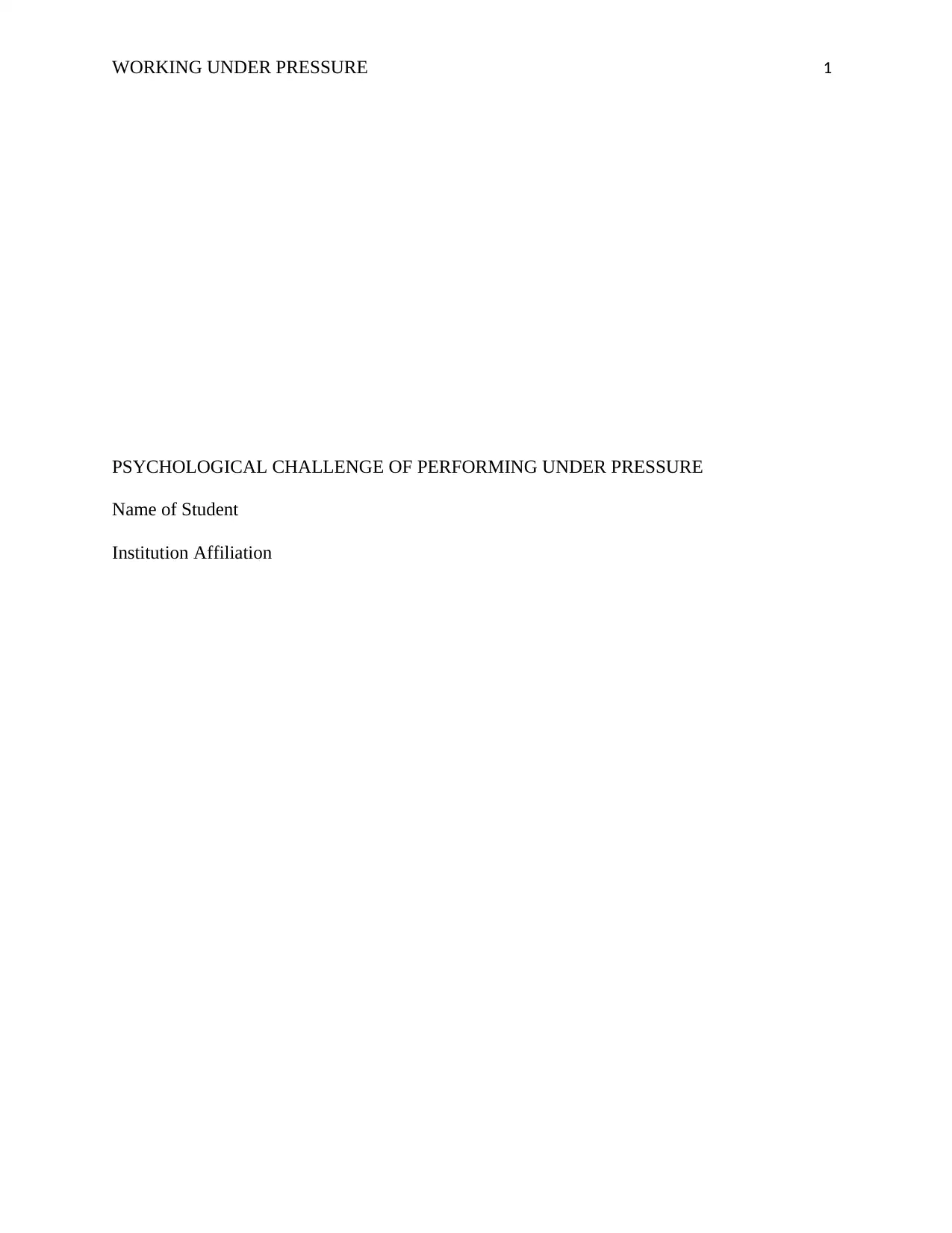
WORKING UNDER PRESSURE 1
PSYCHOLOGICAL CHALLENGE OF PERFORMING UNDER PRESSURE
Name of Student
Institution Affiliation
PSYCHOLOGICAL CHALLENGE OF PERFORMING UNDER PRESSURE
Name of Student
Institution Affiliation
Paraphrase This Document
Need a fresh take? Get an instant paraphrase of this document with our AI Paraphraser
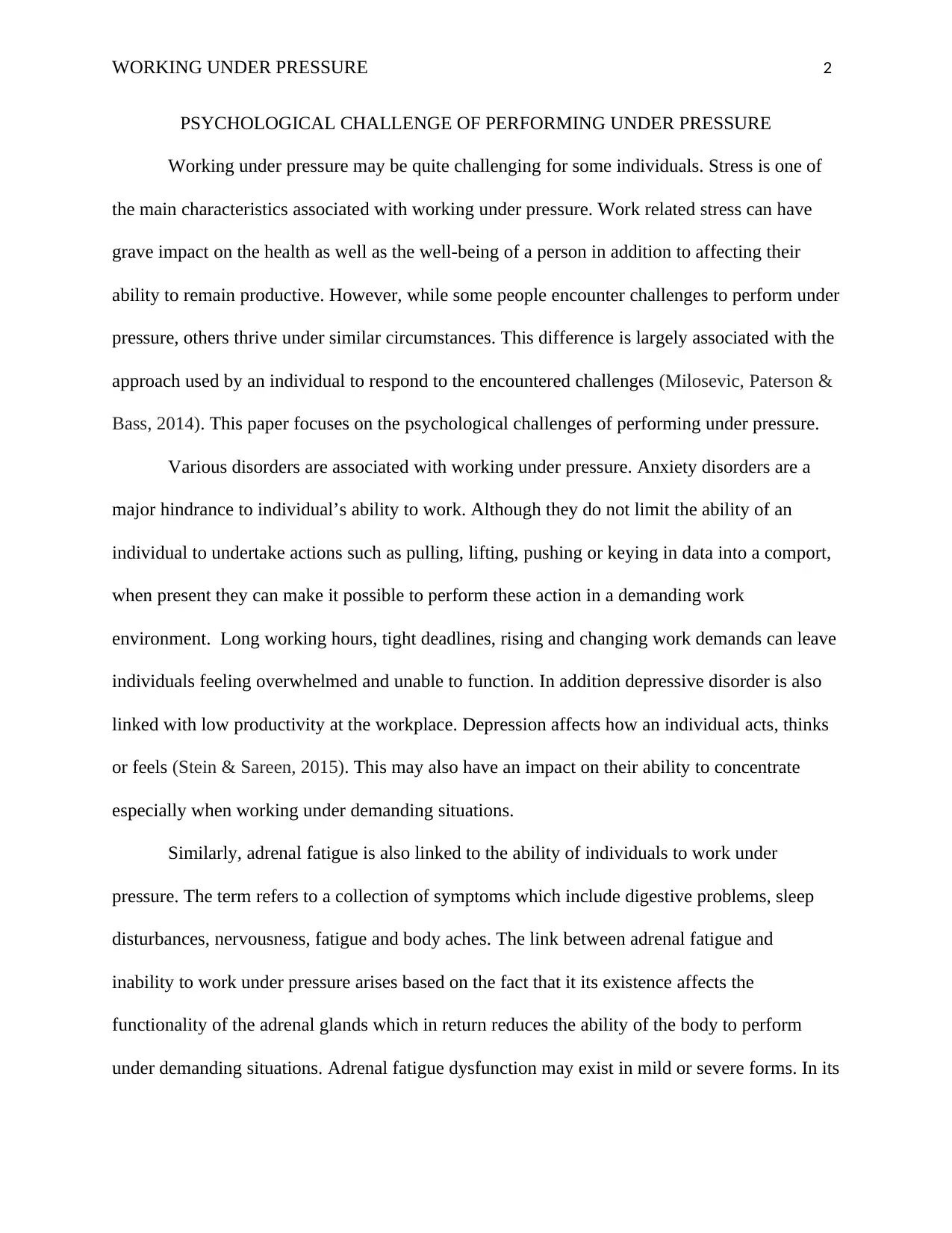
WORKING UNDER PRESSURE 2
PSYCHOLOGICAL CHALLENGE OF PERFORMING UNDER PRESSURE
Working under pressure may be quite challenging for some individuals. Stress is one of
the main characteristics associated with working under pressure. Work related stress can have
grave impact on the health as well as the well-being of a person in addition to affecting their
ability to remain productive. However, while some people encounter challenges to perform under
pressure, others thrive under similar circumstances. This difference is largely associated with the
approach used by an individual to respond to the encountered challenges (Milosevic, Paterson &
Bass, 2014). This paper focuses on the psychological challenges of performing under pressure.
Various disorders are associated with working under pressure. Anxiety disorders are a
major hindrance to individual’s ability to work. Although they do not limit the ability of an
individual to undertake actions such as pulling, lifting, pushing or keying in data into a comport,
when present they can make it possible to perform these action in a demanding work
environment. Long working hours, tight deadlines, rising and changing work demands can leave
individuals feeling overwhelmed and unable to function. In addition depressive disorder is also
linked with low productivity at the workplace. Depression affects how an individual acts, thinks
or feels (Stein & Sareen, 2015). This may also have an impact on their ability to concentrate
especially when working under demanding situations.
Similarly, adrenal fatigue is also linked to the ability of individuals to work under
pressure. The term refers to a collection of symptoms which include digestive problems, sleep
disturbances, nervousness, fatigue and body aches. The link between adrenal fatigue and
inability to work under pressure arises based on the fact that it its existence affects the
functionality of the adrenal glands which in return reduces the ability of the body to perform
under demanding situations. Adrenal fatigue dysfunction may exist in mild or severe forms. In its
PSYCHOLOGICAL CHALLENGE OF PERFORMING UNDER PRESSURE
Working under pressure may be quite challenging for some individuals. Stress is one of
the main characteristics associated with working under pressure. Work related stress can have
grave impact on the health as well as the well-being of a person in addition to affecting their
ability to remain productive. However, while some people encounter challenges to perform under
pressure, others thrive under similar circumstances. This difference is largely associated with the
approach used by an individual to respond to the encountered challenges (Milosevic, Paterson &
Bass, 2014). This paper focuses on the psychological challenges of performing under pressure.
Various disorders are associated with working under pressure. Anxiety disorders are a
major hindrance to individual’s ability to work. Although they do not limit the ability of an
individual to undertake actions such as pulling, lifting, pushing or keying in data into a comport,
when present they can make it possible to perform these action in a demanding work
environment. Long working hours, tight deadlines, rising and changing work demands can leave
individuals feeling overwhelmed and unable to function. In addition depressive disorder is also
linked with low productivity at the workplace. Depression affects how an individual acts, thinks
or feels (Stein & Sareen, 2015). This may also have an impact on their ability to concentrate
especially when working under demanding situations.
Similarly, adrenal fatigue is also linked to the ability of individuals to work under
pressure. The term refers to a collection of symptoms which include digestive problems, sleep
disturbances, nervousness, fatigue and body aches. The link between adrenal fatigue and
inability to work under pressure arises based on the fact that it its existence affects the
functionality of the adrenal glands which in return reduces the ability of the body to perform
under demanding situations. Adrenal fatigue dysfunction may exist in mild or severe forms. In its
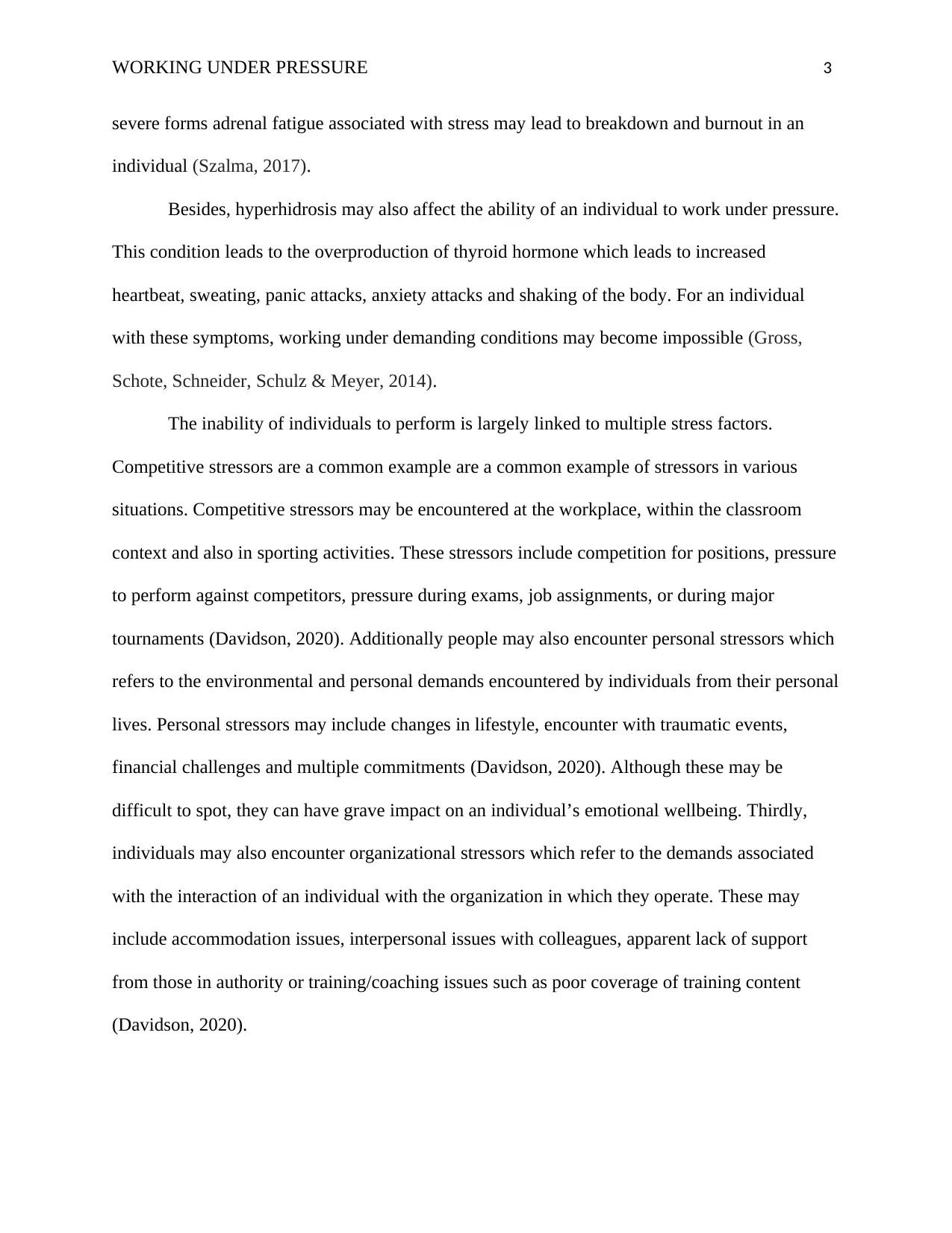
WORKING UNDER PRESSURE 3
severe forms adrenal fatigue associated with stress may lead to breakdown and burnout in an
individual (Szalma, 2017).
Besides, hyperhidrosis may also affect the ability of an individual to work under pressure.
This condition leads to the overproduction of thyroid hormone which leads to increased
heartbeat, sweating, panic attacks, anxiety attacks and shaking of the body. For an individual
with these symptoms, working under demanding conditions may become impossible (Gross,
Schote, Schneider, Schulz & Meyer, 2014).
The inability of individuals to perform is largely linked to multiple stress factors.
Competitive stressors are a common example are a common example of stressors in various
situations. Competitive stressors may be encountered at the workplace, within the classroom
context and also in sporting activities. These stressors include competition for positions, pressure
to perform against competitors, pressure during exams, job assignments, or during major
tournaments (Davidson, 2020). Additionally people may also encounter personal stressors which
refers to the environmental and personal demands encountered by individuals from their personal
lives. Personal stressors may include changes in lifestyle, encounter with traumatic events,
financial challenges and multiple commitments (Davidson, 2020). Although these may be
difficult to spot, they can have grave impact on an individual’s emotional wellbeing. Thirdly,
individuals may also encounter organizational stressors which refer to the demands associated
with the interaction of an individual with the organization in which they operate. These may
include accommodation issues, interpersonal issues with colleagues, apparent lack of support
from those in authority or training/coaching issues such as poor coverage of training content
(Davidson, 2020).
severe forms adrenal fatigue associated with stress may lead to breakdown and burnout in an
individual (Szalma, 2017).
Besides, hyperhidrosis may also affect the ability of an individual to work under pressure.
This condition leads to the overproduction of thyroid hormone which leads to increased
heartbeat, sweating, panic attacks, anxiety attacks and shaking of the body. For an individual
with these symptoms, working under demanding conditions may become impossible (Gross,
Schote, Schneider, Schulz & Meyer, 2014).
The inability of individuals to perform is largely linked to multiple stress factors.
Competitive stressors are a common example are a common example of stressors in various
situations. Competitive stressors may be encountered at the workplace, within the classroom
context and also in sporting activities. These stressors include competition for positions, pressure
to perform against competitors, pressure during exams, job assignments, or during major
tournaments (Davidson, 2020). Additionally people may also encounter personal stressors which
refers to the environmental and personal demands encountered by individuals from their personal
lives. Personal stressors may include changes in lifestyle, encounter with traumatic events,
financial challenges and multiple commitments (Davidson, 2020). Although these may be
difficult to spot, they can have grave impact on an individual’s emotional wellbeing. Thirdly,
individuals may also encounter organizational stressors which refer to the demands associated
with the interaction of an individual with the organization in which they operate. These may
include accommodation issues, interpersonal issues with colleagues, apparent lack of support
from those in authority or training/coaching issues such as poor coverage of training content
(Davidson, 2020).
⊘ This is a preview!⊘
Do you want full access?
Subscribe today to unlock all pages.

Trusted by 1+ million students worldwide
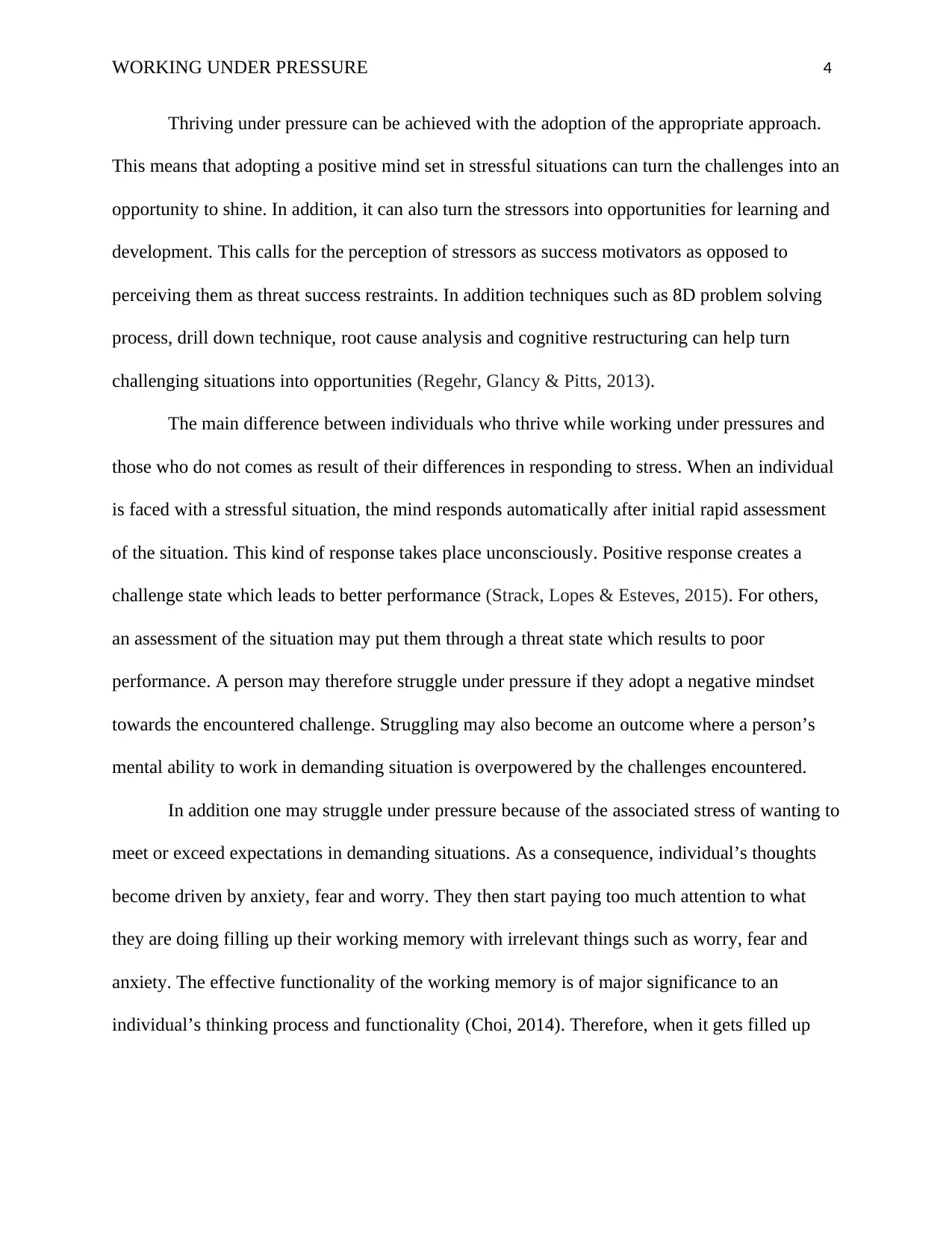
WORKING UNDER PRESSURE 4
Thriving under pressure can be achieved with the adoption of the appropriate approach.
This means that adopting a positive mind set in stressful situations can turn the challenges into an
opportunity to shine. In addition, it can also turn the stressors into opportunities for learning and
development. This calls for the perception of stressors as success motivators as opposed to
perceiving them as threat success restraints. In addition techniques such as 8D problem solving
process, drill down technique, root cause analysis and cognitive restructuring can help turn
challenging situations into opportunities (Regehr, Glancy & Pitts, 2013).
The main difference between individuals who thrive while working under pressures and
those who do not comes as result of their differences in responding to stress. When an individual
is faced with a stressful situation, the mind responds automatically after initial rapid assessment
of the situation. This kind of response takes place unconsciously. Positive response creates a
challenge state which leads to better performance (Strack, Lopes & Esteves, 2015). For others,
an assessment of the situation may put them through a threat state which results to poor
performance. A person may therefore struggle under pressure if they adopt a negative mindset
towards the encountered challenge. Struggling may also become an outcome where a person’s
mental ability to work in demanding situation is overpowered by the challenges encountered.
In addition one may struggle under pressure because of the associated stress of wanting to
meet or exceed expectations in demanding situations. As a consequence, individual’s thoughts
become driven by anxiety, fear and worry. They then start paying too much attention to what
they are doing filling up their working memory with irrelevant things such as worry, fear and
anxiety. The effective functionality of the working memory is of major significance to an
individual’s thinking process and functionality (Choi, 2014). Therefore, when it gets filled up
Thriving under pressure can be achieved with the adoption of the appropriate approach.
This means that adopting a positive mind set in stressful situations can turn the challenges into an
opportunity to shine. In addition, it can also turn the stressors into opportunities for learning and
development. This calls for the perception of stressors as success motivators as opposed to
perceiving them as threat success restraints. In addition techniques such as 8D problem solving
process, drill down technique, root cause analysis and cognitive restructuring can help turn
challenging situations into opportunities (Regehr, Glancy & Pitts, 2013).
The main difference between individuals who thrive while working under pressures and
those who do not comes as result of their differences in responding to stress. When an individual
is faced with a stressful situation, the mind responds automatically after initial rapid assessment
of the situation. This kind of response takes place unconsciously. Positive response creates a
challenge state which leads to better performance (Strack, Lopes & Esteves, 2015). For others,
an assessment of the situation may put them through a threat state which results to poor
performance. A person may therefore struggle under pressure if they adopt a negative mindset
towards the encountered challenge. Struggling may also become an outcome where a person’s
mental ability to work in demanding situation is overpowered by the challenges encountered.
In addition one may struggle under pressure because of the associated stress of wanting to
meet or exceed expectations in demanding situations. As a consequence, individual’s thoughts
become driven by anxiety, fear and worry. They then start paying too much attention to what
they are doing filling up their working memory with irrelevant things such as worry, fear and
anxiety. The effective functionality of the working memory is of major significance to an
individual’s thinking process and functionality (Choi, 2014). Therefore, when it gets filled up
Paraphrase This Document
Need a fresh take? Get an instant paraphrase of this document with our AI Paraphraser
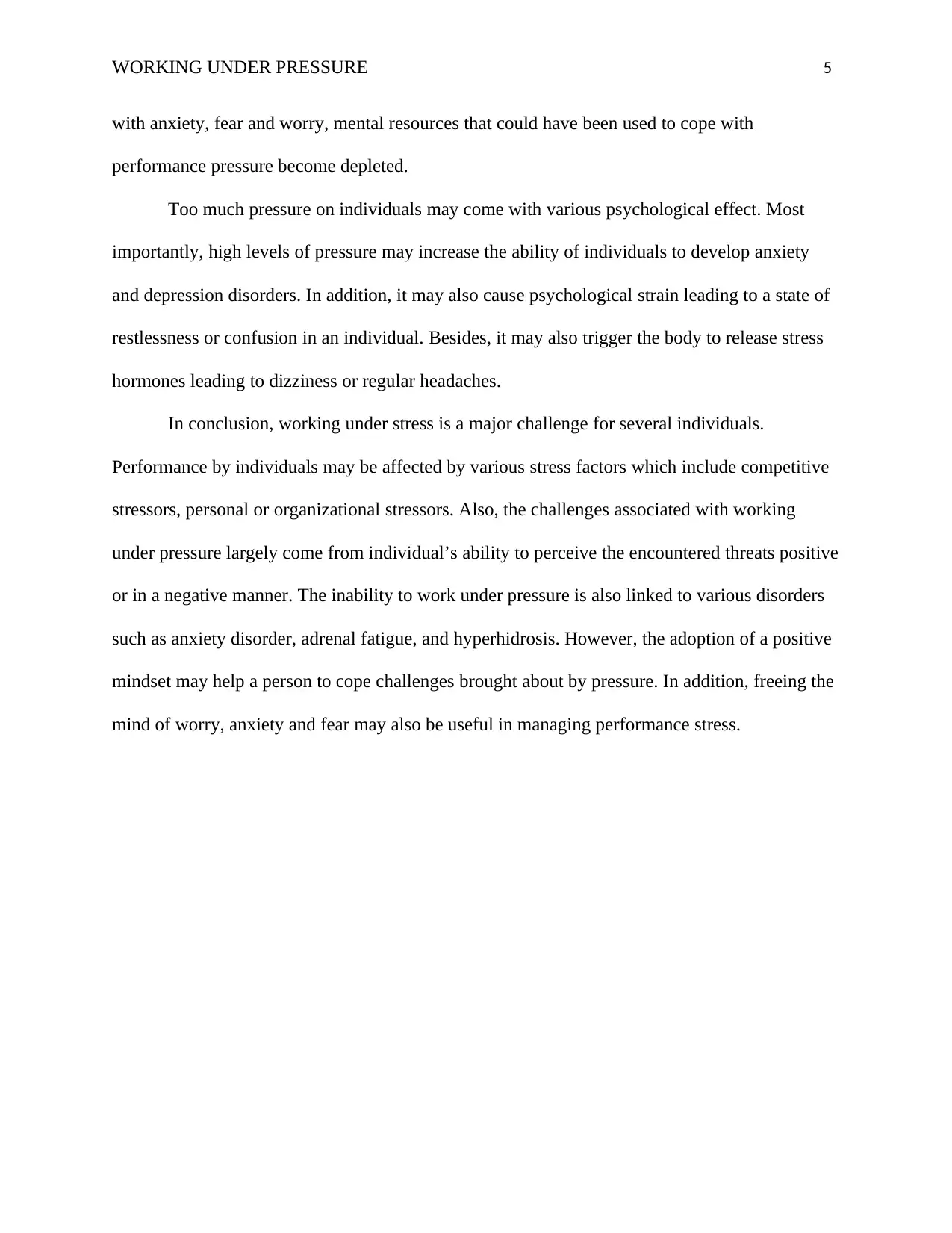
WORKING UNDER PRESSURE 5
with anxiety, fear and worry, mental resources that could have been used to cope with
performance pressure become depleted.
Too much pressure on individuals may come with various psychological effect. Most
importantly, high levels of pressure may increase the ability of individuals to develop anxiety
and depression disorders. In addition, it may also cause psychological strain leading to a state of
restlessness or confusion in an individual. Besides, it may also trigger the body to release stress
hormones leading to dizziness or regular headaches.
In conclusion, working under stress is a major challenge for several individuals.
Performance by individuals may be affected by various stress factors which include competitive
stressors, personal or organizational stressors. Also, the challenges associated with working
under pressure largely come from individual’s ability to perceive the encountered threats positive
or in a negative manner. The inability to work under pressure is also linked to various disorders
such as anxiety disorder, adrenal fatigue, and hyperhidrosis. However, the adoption of a positive
mindset may help a person to cope challenges brought about by pressure. In addition, freeing the
mind of worry, anxiety and fear may also be useful in managing performance stress.
with anxiety, fear and worry, mental resources that could have been used to cope with
performance pressure become depleted.
Too much pressure on individuals may come with various psychological effect. Most
importantly, high levels of pressure may increase the ability of individuals to develop anxiety
and depression disorders. In addition, it may also cause psychological strain leading to a state of
restlessness or confusion in an individual. Besides, it may also trigger the body to release stress
hormones leading to dizziness or regular headaches.
In conclusion, working under stress is a major challenge for several individuals.
Performance by individuals may be affected by various stress factors which include competitive
stressors, personal or organizational stressors. Also, the challenges associated with working
under pressure largely come from individual’s ability to perceive the encountered threats positive
or in a negative manner. The inability to work under pressure is also linked to various disorders
such as anxiety disorder, adrenal fatigue, and hyperhidrosis. However, the adoption of a positive
mindset may help a person to cope challenges brought about by pressure. In addition, freeing the
mind of worry, anxiety and fear may also be useful in managing performance stress.
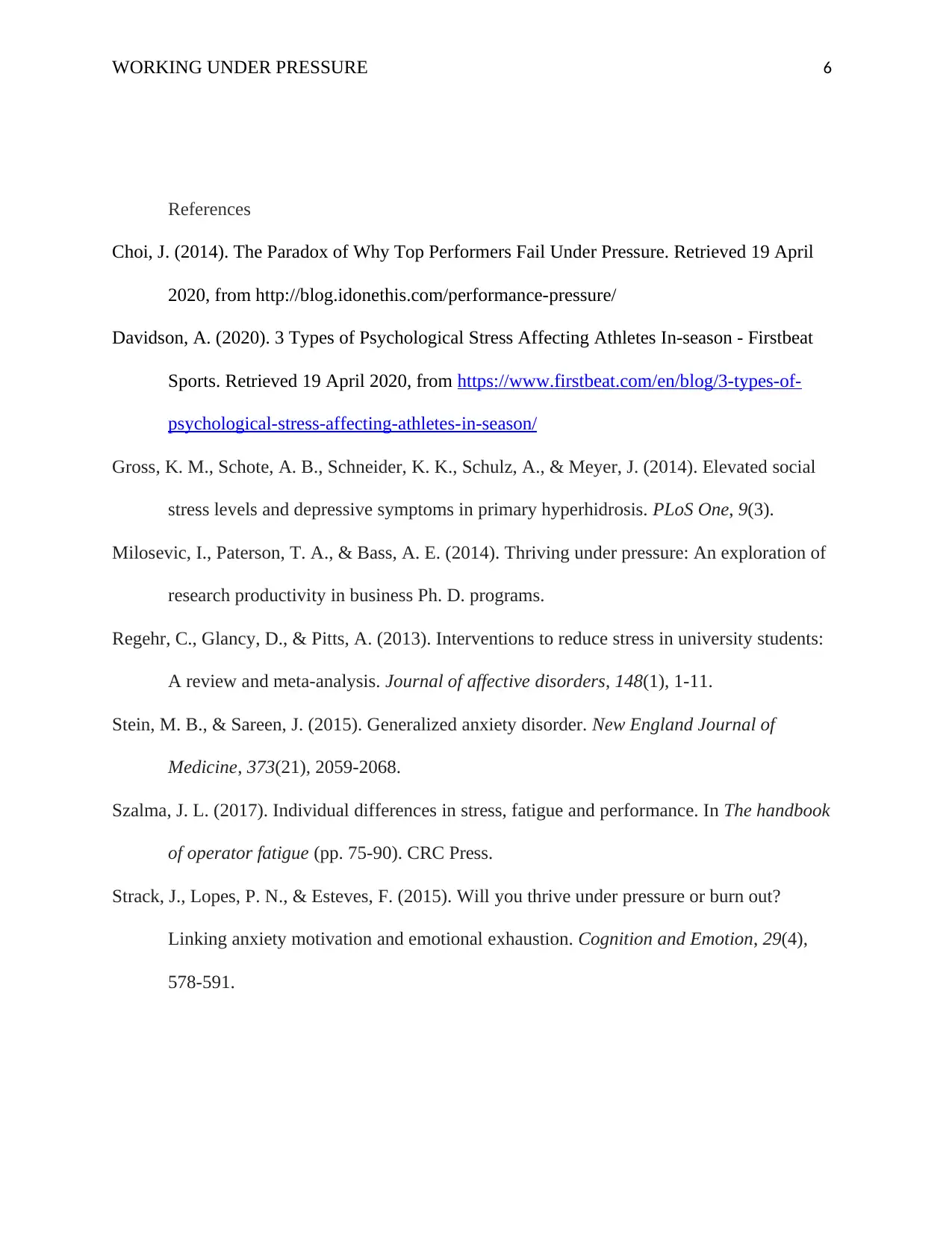
WORKING UNDER PRESSURE 6
References
Choi, J. (2014). The Paradox of Why Top Performers Fail Under Pressure. Retrieved 19 April
2020, from http://blog.idonethis.com/performance-pressure/
Davidson, A. (2020). 3 Types of Psychological Stress Affecting Athletes In-season - Firstbeat
Sports. Retrieved 19 April 2020, from https://www.firstbeat.com/en/blog/3-types-of-
psychological-stress-affecting-athletes-in-season/
Gross, K. M., Schote, A. B., Schneider, K. K., Schulz, A., & Meyer, J. (2014). Elevated social
stress levels and depressive symptoms in primary hyperhidrosis. PLoS One, 9(3).
Milosevic, I., Paterson, T. A., & Bass, A. E. (2014). Thriving under pressure: An exploration of
research productivity in business Ph. D. programs.
Regehr, C., Glancy, D., & Pitts, A. (2013). Interventions to reduce stress in university students:
A review and meta-analysis. Journal of affective disorders, 148(1), 1-11.
Stein, M. B., & Sareen, J. (2015). Generalized anxiety disorder. New England Journal of
Medicine, 373(21), 2059-2068.
Szalma, J. L. (2017). Individual differences in stress, fatigue and performance. In The handbook
of operator fatigue (pp. 75-90). CRC Press.
Strack, J., Lopes, P. N., & Esteves, F. (2015). Will you thrive under pressure or burn out?
Linking anxiety motivation and emotional exhaustion. Cognition and Emotion, 29(4),
578-591.
References
Choi, J. (2014). The Paradox of Why Top Performers Fail Under Pressure. Retrieved 19 April
2020, from http://blog.idonethis.com/performance-pressure/
Davidson, A. (2020). 3 Types of Psychological Stress Affecting Athletes In-season - Firstbeat
Sports. Retrieved 19 April 2020, from https://www.firstbeat.com/en/blog/3-types-of-
psychological-stress-affecting-athletes-in-season/
Gross, K. M., Schote, A. B., Schneider, K. K., Schulz, A., & Meyer, J. (2014). Elevated social
stress levels and depressive symptoms in primary hyperhidrosis. PLoS One, 9(3).
Milosevic, I., Paterson, T. A., & Bass, A. E. (2014). Thriving under pressure: An exploration of
research productivity in business Ph. D. programs.
Regehr, C., Glancy, D., & Pitts, A. (2013). Interventions to reduce stress in university students:
A review and meta-analysis. Journal of affective disorders, 148(1), 1-11.
Stein, M. B., & Sareen, J. (2015). Generalized anxiety disorder. New England Journal of
Medicine, 373(21), 2059-2068.
Szalma, J. L. (2017). Individual differences in stress, fatigue and performance. In The handbook
of operator fatigue (pp. 75-90). CRC Press.
Strack, J., Lopes, P. N., & Esteves, F. (2015). Will you thrive under pressure or burn out?
Linking anxiety motivation and emotional exhaustion. Cognition and Emotion, 29(4),
578-591.
⊘ This is a preview!⊘
Do you want full access?
Subscribe today to unlock all pages.

Trusted by 1+ million students worldwide
1 out of 6
Related Documents
Your All-in-One AI-Powered Toolkit for Academic Success.
+13062052269
info@desklib.com
Available 24*7 on WhatsApp / Email
![[object Object]](/_next/static/media/star-bottom.7253800d.svg)
Unlock your academic potential
Copyright © 2020–2025 A2Z Services. All Rights Reserved. Developed and managed by ZUCOL.





